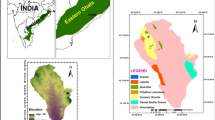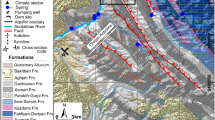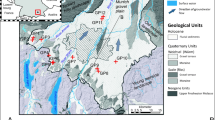Abstract
For a karstified limestone area in NW Vietnam, the relationship between the distribution of lineaments and borehole specific capacity is determined, resulting in the conclusion that not only the borehole geomorphological-hydrogeological position but also the lineament distribution influences the specific capacity.
No significant spatial well yield patterns are evident in this highly fractured-karstified region. The supposition is that lineaments caused by geotectonic activities affect the local variability in borehole specific capacity. Sixteen pumping tests in conjunction with a comprehensive lineament analysis are used to prove this relationship. The boreholes and lineaments are classified into two groups according to their similarity in geomorphological-hydrogeological features. Lineaments tend to be less detectable in discharge areas (lowland, wide and flat valleys) in contrast to the high density in recharge areas (highland narrow-mountainous ravines). In addition, the presence of a stream network in the former can act as a recharge source to the underlain karstic groundwater system. Consequently, boreholes that are in the discharge areas with a lower density of lineaments often produce high yield. For recharge areas with a high density of lineaments, a good correlation is found between lineament density and borehole specific capacity.
Résumé
La relation entre la distribution des linéaments et le rendement des puits est déterminée pour une région dans le nord ouest du Vietnam composée de calcaires karstiques. La conclusion qui résulte de l’analyse de cette relation est que la distribution des linéaments ainsi que leur niveau local d’érosion affectent le rendement des puits. Aucune tendance n’a été observée dans la distribution spatiale des puits selon leur rendement au sein de cette région karstique grandement fracturée. On suppose que les linéaments produits par l’activité géotectonique ont une influence sur la variabilité locale du rendement des puits. Les résultats de seize essais de pompage et une analyse complète des linéaments sont utilisés pour établir la relation. Les puits et les linéaments sont classés en deux groupes selon la similarité de leur caractéristiques géomorphologiques et hydrogéologiques. Les linéaments sont plus difficilement repérables dans les grandes vallées plates que dans les étroites vallées de montagne, qui présentent une densité élevée de linéaments. De plus, la présence de rivières dans les premières peut contribuer à la recharge du système d’écoulement souterrain karstique sous-jacent. Par conséquent, les puits situés dans les régions à faible densité en linéaments, mais qui se trouvent près de linéaments à niveau local d’érosion élevé présentent souvent un rendement élevé. Dans les vallées étroites ayant une grande densité de linéaments, il y a généralement une corrélation élevée entre la densité des linéaments et le rendement des puits.
Resumen
El resultado ha sido la conclusión de que tanto la distribución de lineamientos como el nivel base local de erosión, i. e. la red de arroyos, influyen el rendimiento de los pozos. No hay ningún patrón evidente significativo de rendimiento de pozos según parámetros espaciales en esta región altamente karstificada y fracturada. La suposición es que los lineamientos causados por actividad geotectónica afectan la variabilidad local de rendimiento de los pozos. Se han utilizado dieciséis pruebas de bombeo en conjunción con un análisis de lineamientos amplio para descubrir la relación. Los pozos y lineamientos se han clasificado en dos grupos de acuerdo con sus similitudes en rasgos geomorfológicos-hidrogeológicos. Se tiende a detectar menos lineamientos en valles anchos y planos en contraste con la alta densidad en áreas de valles montańosos angostos. Adicionalmente, la presencia de una red de arroyos en estos últimos puede actuar como fuente de recarga del sistema de aguas subterráneas kárstico subyacente. En consecuencia, los pozos que se encuentran en el área con una menor densidad de lineamientos pero cercanos a un nivel local base de erosión frecuentemente tienen un rendimiento alto. En el caso de los valles angostos con una alta densidad de lineamientos, se ha encontrado una correlación alta entre densidad de lineamientos y rendimiento de pozos.















Similar content being viewed by others
References
Banks D (1992) Estimation of apparent transmissivity from capacity testing of boreholes in bedrock aquifers. Appl Hydrogeol 4:5–19
Blanchet PH (1957) Development of fracture analysis as an exploration method. Bull Am Assoc Petrol Geol 41:1748–1759
Dusar M, Masschelein J, Tien PC and Tuyet D (1994) Belgian-Vietnamese Speleological expedition. Son La 1993. Belg Geol Survey Prof Pap 1994/4-No271, 60 pp
Edet AE, Okereke CS, Teme SC, Esu EO (1998) Application of remote-sensing data to groundwater exploration: a case study of the Cross River State, southeastern Nigeria. Hydrogeol J 6:394–404
El-Naqua A (1994) Estimation of transmissivity from specific capacity data in fractured carbonate rock aquifer, Central Jordan. Environ Geol 23(1):73–80
Greenbaum D (1985) Review of remote sensing applications to groundwater exploration in basement and regolith. Brit Geol Surv Rep OD 85/8, 36 pp
Hop ND (1996) Report on geological mapping scaled 1:50000, Thuan Chau Area [in Vietnamese]. Research Institute of Geology and Mineral Resources of Vietnam, Hanoi, 178 pp
Hung LQ, Dinh NQ, Batelaan O, Tam VT, Lagrou D (2002) Remote sensing and GIS-based analysis of cave development in the Suoimuoi Catchment (Son La—NW Vietnam). J Cave Karst Stud 64(1):23–33
Huntley D, Nommensen R, Steffey D (1992) The use of specific capacity to assess transmissivity in fractured-rock aquifer. Ground Water 30(3):396–402
Kazemi H, Seth MS, Thomas GW (1969) The interpretation of interference tests in naturally fractured reservoirs with uniform fracture distribution. Soc Petrol Eng J (18):463–472
Krásný J (1974) Les différences de la transmissivité, statistiquement significatives, dans les zones de l’infiltration et du drainage. Mém Assoc Intl Hydrogeol 10, l. Communications, pp 204–211
Krásný J (1998) Groundwater discharge zones: sensitive areas of surface water—groundwater interaction. In: Van Brahama J, Eckstein Y, Ongley LK, Schneider R, Moore JE (eds) Gambling with groundwater—physical, chemical, and biological aspects of aquifer stream relations. Proceeding of the 28th IAH Congress, pp 111–116
Krásný J (1999) Hard-rock hydrogeology in the Czech Republic. Hydrogéol Orléans (2):25–38
Lagrou D, Masschelein J, Philips P, Tuyet D (2001) Belgian-Vietnamese speleological expedition 2001. SPEKUL Speloeclub van de Universiteit te Leuven, 58 pp
Lattman LH (1958) Technique of mapping geologic fracture traces and lineaments on aerial photographs. Photogram Eng 19(4):568–576
Lattman LH, Parizek RR (1964) Relationship between fracture traces and the occurrence of ground water in carbonate rocks. J Hydrol 2:73–91
Mabee SB, Hardcastle KC, Wise DW (1994) A method of collecting and analyzing lineaments for regional-scale fractured bedrock aquifer studies. Ground Water 32(6):884–894
Mace RE (1997) Determination of transmissivity from specific capacity tests in a karst aquifer. Ground Water 35(5):738–742
Magowe M, Carr JR (1999) Relationship between lineaments and groundwater occurrence in Western Botswana. Ground Water 37(2):282–286
Meier PM, Carrera J, Sanchez-Vila X (1999) A numerical study on the relationship between transmissivity and specific capacity in heterogeneous aquifers. Ground Water 37(4):611–617
November J (1999) Karst geological investigation in the area of Son La and Thuan Chau (NW-Vietnam) [in Dutch]. KULeuven, Lic.-dissertation, 135 pp
Sander P, Minor TB, Chesley MM (1997) Ground-water exploration based on lineament analysis and reproducibility tests. Ground Water 35(5):888–894
Tam VT, Vu TMN, Batelaan O (2001) Hydrogeological characteristics of a karst mountainous catchment in the Northwest of Vietnam. Acta Geologica Sinica (English Edition) 75(3):260–268
Warren JE, Root PJ (1963) The behaviour of naturally fractured reservoirs. Soc Petrol Eng J (3):245–255
Xuyen CX (1998) Report on hydrogeological mapping scaled 1:200000, Dien Bien Yen Bai Area [in Vietnamese]. Geol Surv Vietnam, 202 pp
Acknowledgements
This work has been carried out within the project A3210 “Rural development in the mountain karst area of NW Vietnam by sustainable water and land management and social learning: its conditions and facilitation (VIBEKAP)” funded by the Flemish University Council (VLIR). The authors are grateful to all VIBEKAP’s participants for their contributions. Special thanks are paid to Mr. Cao Xuan Xuyen (Geological Survey of Vietnam) and Dr. Koen Van Keer (former VIBEKAP coordinator) for their support in data collection of the pumping tests. Mr. Nguyen Xuan Nam is acknowledged for his contribution on building the pumping test database.
Author information
Authors and Affiliations
Corresponding author
Rights and permissions
About this article
Cite this article
Tam, V.T., De Smedt, F., Batelaan, O. et al. Study on the relationship between lineaments and borehole specific capacity in a fractured and karstified limestone area in Vietnam. Hydrogeology Journal 12, 662–673 (2004). https://doi.org/10.1007/s10040-004-0329-1
Received:
Accepted:
Published:
Issue Date:
DOI: https://doi.org/10.1007/s10040-004-0329-1




